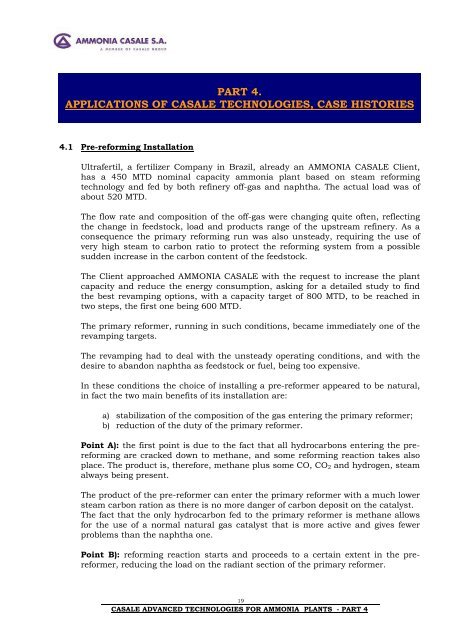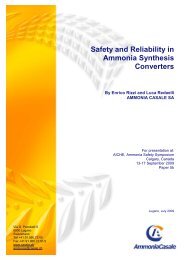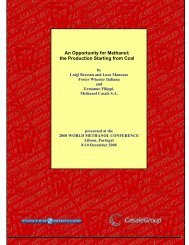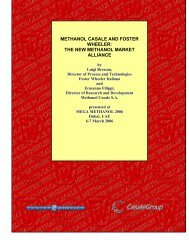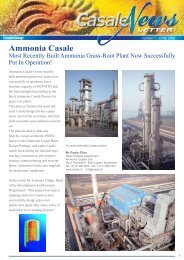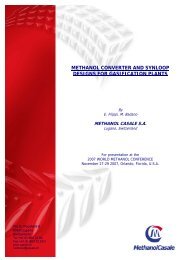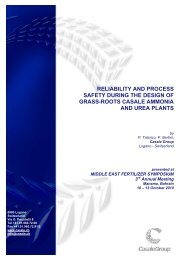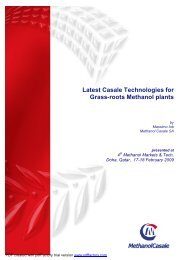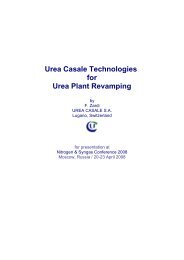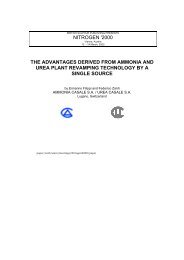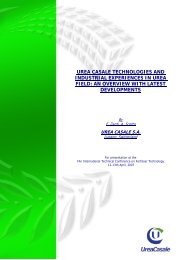ADVANCED AMMONIA CASALE ... - CASALE GROUP
ADVANCED AMMONIA CASALE ... - CASALE GROUP
ADVANCED AMMONIA CASALE ... - CASALE GROUP
Create successful ePaper yourself
Turn your PDF publications into a flip-book with our unique Google optimized e-Paper software.
PART 4.<br />
APPLICATIONS OF <strong>CASALE</strong> TECHNOLOGIES, CASE HISTORIES<br />
4.1 Pre-reforming Installation<br />
Ultrafertil, a fertilizer Company in Brazil, already an <strong>AMMONIA</strong> <strong>CASALE</strong> Client,<br />
has a 450 MTD nominal capacity ammonia plant based on steam reforming<br />
technology and fed by both refinery off-gas and naphtha. The actual load was of<br />
about 520 MTD.<br />
The flow rate and composition of the off-gas were changing quite often, reflecting<br />
the change in feedstock, load and products range of the upstream refinery. As a<br />
consequence the primary reforming run was also unsteady, requiring the use of<br />
very high steam to carbon ratio to protect the reforming system from a possible<br />
sudden increase in the carbon content of the feedstock.<br />
The Client approached <strong>AMMONIA</strong> <strong>CASALE</strong> with the request to increase the plant<br />
capacity and reduce the energy consumption, asking for a detailed study to find<br />
the best revamping options, with a capacity target of 800 MTD, to be reached in<br />
two steps, the first one being 600 MTD.<br />
The primary reformer, running in such conditions, became immediately one of the<br />
revamping targets.<br />
The revamping had to deal with the unsteady operating conditions, and with the<br />
desire to abandon naphtha as feedstock or fuel, being too expensive.<br />
In these conditions the choice of installing a pre-reformer appeared to be natural,<br />
in fact the two main benefits of its installation are:<br />
a) stabilization of the composition of the gas entering the primary reformer;<br />
b) reduction of the duty of the primary reformer.<br />
Point A): the first point is due to the fact that all hydrocarbons entering the prereforming<br />
are cracked down to methane, and some reforming reaction takes also<br />
place. The product is, therefore, methane plus some CO, CO2 and hydrogen, steam<br />
always being present.<br />
The product of the pre-reformer can enter the primary reformer with a much lower<br />
steam carbon ration as there is no more danger of carbon deposit on the catalyst.<br />
The fact that the only hydrocarbon fed to the primary reformer is methane allows<br />
for the use of a normal natural gas catalyst that is more active and gives fewer<br />
problems than the naphtha one.<br />
Point B): reforming reaction starts and proceeds to a certain extent in the prereformer,<br />
reducing the load on the radiant section of the primary reformer.<br />
19<br />
<strong>CASALE</strong> <strong>ADVANCED</strong> TECHNOLOGIES FOR <strong>AMMONIA</strong> PLANTS - PART 4


